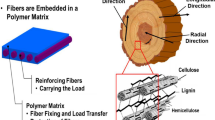Summary
The work described was primarily concerned with determining the more important variables affecting friction between wood and steel, but friction between wood and non-ferrous materials including wood itself was also investigated briefly. Deviations from the classical laws of friction were of interest, the most significant being variation of friction coefficient with sliding speed. With an increase in sliding speed up to 4 m/sec the curves for highly polished steel showed undulations, but with unpolished surfaces there was a monotonic reduction, somewhat greater in wet wood than dry. Other important factors, interacting with sliding speed, were steel roughness and wood moisture content. Effects of load, nominal contact area and fibre direction were minor. The results appear to be adequately explained in terms of adhesion and lubrication.
A world wide selection of species was tested, and it appears that the nature and amount of extractives in most woods is such that they have similar friction coefficients except on very smooth steel, and only a few “greasy” species, have significantly lower coefficients. For most air-dry wood in contact with unpolished steel, the coefficient decreases from a static value about 0.65 to a value about 0.4 at 4 m/sec. For wet wood, the corresponding values are about 0.7 and 0.15.
Coefficients of friction between wood and wood were similar to those between wood and rough steel, and those between wood and other materials varied in a manner which may be related to strength of adhesion.
Zusammenfassung
Die ursprüngliche Zielsetzung der Arbeit, die Untersuchung der wesentlichen Einflußgrößen auf die Reibung zwischen Holz und Stahl wurde durch Einbeziehung von Nichteisen-Metallen und der Reibung zwischen Holz und Holz erwitert. Als bemerkenswert stellten sich die Abweichungen von den klassischen Reibungsgesetzen heraus, am auffallendsten die Änderung der Reibung mit der Vorschubgeschwindigkeit. Beim Anstieg der Vorschubgeschwindigkeit bis zu 4 m/s zeigten die Kurven für hochglanzpolierten Stahl Unstetigkeiten, während bei unpoliertem Stahl ein gleichförmiger Abfall eintrat, der bei nassem Holz etwas größer war als bei trockenem. Weitere wichtige Einflußgrößen waren Stahlart und Holzfeuchtigkeit. Die Wirkungen von Normaldruck, Kontaktfläche und Faserrichtung waren von untergeordneter Bedeutung. Die erzielten Ergebnisse lassen sich in etwa gleicher Weise durch Begriffe aus den Gebieten der Adhäsion oder der Schmierung beschreiben.
Es wurde angestrebt, möglichst alle wichtigen Holzarten der Welt zu erfassen. Man kann sagen, daß die Inhaltsstoffe der meisten Hölzer nach Art und Menge zu ziemlich ähnlichen Reibungskoeffizienten führen, ausgenommen bei sehr “glatten” Stahlarten. Nur wenige “fetthaltige” Holzarten weisen deutlich niedrigere Reibungskoeffizienten auf. Für lufttrockenes Holz und unpolierten Stahl fällt der Koeffizient von 0,65 für Haftreibung auf 0,40 für gleitende Reibung bei 4 m/s Vorschubgeschwindigkeit. Bei nassem Holz lauten die entsprechenden Werte 0,70 und 0,15. Die Reibungskoeffizienten zwischen Holz und Holz waren ähnlich denen zwischen Holz und rauhem Stahl; diejenigen zwischen Holz und anderen Materialien variierten so, daß ein Zusammenhang mit den Adhäsionskräften anzunehmen ist.
Similar content being viewed by others
References
Atack, D., and D. Tabor: The Friction of Wood. Proc. Roy. Soc. Vol. A 246 (1958) p. 539.
Bowden, F. P., and D. Tabor: The Friction and Lubrication of Solids, Part I. Oxford 1953: Clarendon Press.
Bowden, F. P., and D. Tabor: The Friction and Lubrication of Solids, Part II. Oxford 1964 Clarendon Press.
Clarke, L. N.: A New Dynamometer for Measuring Cutting Forces in Three Dimensions. Div. Forest Products Tech. Paper No. 30, CSIRO Australia (1963).
Higgins, H. G., and A. W. McKenzie: The Structure and Properties of Paper. Appita Vol. 16 (1958): No. 6.
Klein, L.: Z. VDI Vol. 47 (1903). Quoted by F. Kollmann: Technologie des Holzes und der Holzwerkstoffe, Vol. 1, p. 569/570. Berlin 1951: Springer.
Kragelskii, I. V.: Friction and Wear. Trans. from Russian by L. Ronson, London 1965: Butterworth.
McLaren, K. G., and D. Tabor: Frictional Properties of Lignum-Vitae. Brit. J. Appl. Phys. Vol. 12 (1961): p. 118.
Morin: Acad. Roy. des Sciences (1838). Quoted by L. S. Marks: Mechanical Engineers' Handbook, 6th Ed., Vol. 3, p. 40. New York 1958: McGraw Hill.
Niemann, G., and K. Banaschek: Friction Coefficient of Lubricated Surfaces. Z. VDI Vol. 1953 p. 95/167.
Rabinowicz, E.: Friction and Wear of Materials. New York 1965: Wiley.
Singh, B. R.: Sensitivity of Slow Shifting under Stick-Slip Conditions. The Eng. Vol. 6 (1960) p. 187/190.
Author information
Authors and Affiliations
Rights and permissions
About this article
Cite this article
McKenzie, W.M., Karpovich, H. The frictional behaviour of wood. Wood Sci.Technol. 2, 139–152 (1968). https://doi.org/10.1007/BF00394962
Received:
Issue Date:
DOI: https://doi.org/10.1007/BF00394962




